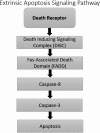Apoptosis and Vocal Fold Disease: Clinically Relevant Implications of Epithelial Cell Death
- PMID: 28492834
- PMCID: PMC5755547
- DOI: 10.1044/2016_JSLHR-S-16-0326
Apoptosis and Vocal Fold Disease: Clinically Relevant Implications of Epithelial Cell Death
Abstract
Purpose: Vocal fold diseases affecting the epithelium have a detrimental impact on vocal function. This review article provides an overview of apoptosis, the most commonly studied type of programmed cell death. Because apoptosis can damage epithelial cells, this article examines the implications of apoptosis on diseases affecting the vocal fold cover.
Method: A review of the extant literature was performed. We summarized the topics of epithelial tissue properties and apoptotic cell death, described what is currently understood about apoptosis in the vocal fold, and proposed several possible explanations for how the role of abnormal apoptosis during wound healing may be involved in vocal pathology.
Results and conclusions: Apoptosis plays an important role in maintaining normal epithelial tissue function. The biological mechanisms responsible for vocal fold diseases of epithelial origin are only beginning to emerge. This article discusses speculations to explain the potential role of deficient versus excessive rates of apoptosis and how disorganized apoptosis may contribute to the development of common diseases of the vocal folds.
Figures
Similar articles
-
Apoptosis in Vocal Fold Polyps.J Voice. 2018 Jan;32(1):104-108. doi: 10.1016/j.jvoice.2017.03.023. Epub 2017 May 2. J Voice. 2018. PMID: 28476217
-
[Mechanical properties of the human vocal fold in vivo--in the case of vocal fold diseases].Nihon Jibiinkoka Gakkai Kaiho. 1982 Jun 20;85(6):654-66. Nihon Jibiinkoka Gakkai Kaiho. 1982. PMID: 7131124 Japanese. No abstract available.
-
[The autoimmune rheumatic disease and laryngeal pathology].Vestn Otorinolaringol. 2017;82(5):80-84. doi: 10.17116/otorino201782580-84. Vestn Otorinolaringol. 2017. PMID: 29072672 Review. Russian.
-
In vivo measurement of the elastic properties of the human vocal fold.Eur Arch Otorhinolaryngol. 2006 May;263(5):455-62. doi: 10.1007/s00405-005-1034-y. Epub 2006 Feb 22. Eur Arch Otorhinolaryngol. 2006. PMID: 16496110
-
Sarcoidosis Presenting as Bilateral Vocal Fold Immobility.J Voice. 2018 May;32(3):359-362. doi: 10.1016/j.jvoice.2017.05.017. Epub 2017 Jul 3. J Voice. 2018. PMID: 28684250 Review.
Cited by
-
Unraveling the molecular pathobiology of vocal fold systemic dehydration using an in vivo rabbit model.PLoS One. 2020 Jul 31;15(7):e0236348. doi: 10.1371/journal.pone.0236348. eCollection 2020. PLoS One. 2020. PMID: 32735560 Free PMC article.
-
Expanded Basal Compartment and Disrupted Barrier in Vocal Fold Epithelium Infected with Mouse Papillomavirus MmuPV1.Viruses. 2022 May 16;14(5):1059. doi: 10.3390/v14051059. Viruses. 2022. PMID: 35632798 Free PMC article.
-
Singer's Nodules: Investigating the Etiopathogenetic Markers Progressing Their Pathogenesis and Clinical Manifestations.Biology (Basel). 2021 Dec 3;10(12):1268. doi: 10.3390/biology10121268. Biology (Basel). 2021. PMID: 34943184 Free PMC article.
-
Hydrogel-Supported, Engineered Model of Vocal Fold Epithelium.ACS Biomater Sci Eng. 2021 Sep 13;7(9):4305-4317. doi: 10.1021/acsbiomaterials.0c01741. Epub 2021 Feb 26. ACS Biomater Sci Eng. 2021. PMID: 33635635 Free PMC article.
-
Overexpression of miR‑375 reverses the effects of dexamethasone on the viability, migration, invasion and apoptosis of human airway epithelial cells by targeting DUSP6.Int J Mol Med. 2022 Mar;49(3):26. doi: 10.3892/ijmm.2022.5081. Epub 2022 Jan 11. Int J Mol Med. 2022. PMID: 35014672 Free PMC article.
References
-
- Ashkenazi A., & Dixit V. M. (1998). Death receptors: Signaling and modulation. Science, 281(5381), 1305–1308. - PubMed
-
- Boccafoschi F., Sabbatini M., Bosetti M., & Cannas M. (2010). Overstressed mechanical stretching activates survival and apoptotic signals in fibroblasts. Cells, Tissues, Organs, 192, 167–176. - PubMed
-
- Branski R. C., Verdolini K., Sandulache V., Rosen C. A., & Hebda P. A. (2006). Vocal fold wound healing: A review for clinicians. Journal of Voice, 20, 432–442. - PubMed
-
- Cory S., & Adams J. M. (2002). The Bcl2 family: Regulators of the cellular life-or-death switch. Nature Reviews Cancer, 2, 647–656. - PubMed
Publication types
MeSH terms
Grants and funding
LinkOut - more resources
Full Text Sources
Other Literature Sources



